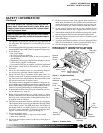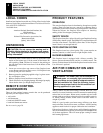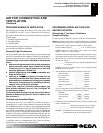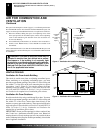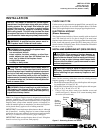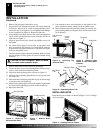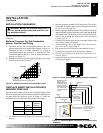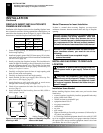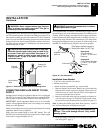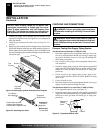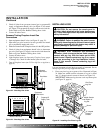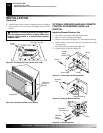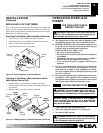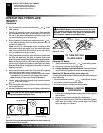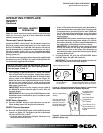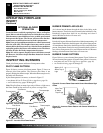Special offers from our partners!

Find Replacement BBQ Parts for 20,308 Models. Repair your BBQ today.

110150-01B
For more information, visit www.desatech.com
For more information, visit www.desatech.com
11
11
INSTALLATION
Continued
INSTALLATION
Installing Gas Piping To Fireplace Location (Cont.)
Connecting Fireplace Insert To Gas Supply
WARNING: Never connect natural gas fireplace
insert to private (non-utility) gas wells. This gas is
commonly known as wellhead gas.
CAUTION: Use only new, black iron or steel pipe.
Internally-tinned copper tubing may be used in cer-
tain areas. Check your local codes. Use pipe of 1/2"
diameter or greater to allow proper gas volume to
fireplace insert. If pipe is too small, undue loss of
volume will occur.
WARNING: Use pipe joint sealant that is resistant
to liquid petroleum (LP) gas.
We recommend that you install a sediment trap in supply line as
shown in Figure 18. Locate sediment trap where it is within reach for
cleaning. Install in piping system between fuel supply and heater.
Locate sediment trap where trapped matter is not likely to freeze. A
sediment trap traps moisture and contaminants. This keeps them
from going into fireplace insert gas controls. If sediment trap is not
installed or is installed wrong, fireplace may not run properly.
CONNECTING FIREPLACE INSERT TO GAS
SUPPLY
Installation must include an equipment shutoff valve, and plugged
1/8" NPT tap. Locate NPT tap within reach for test gauge hook up.
NPT tap must be upstream from fireplace insert (see Figure 18).
IMPORTANT:
Install equipment shutoff valve in an accessible
location. The equipment shutoff valve is for turning on or shutting
off the gas to the appliance.
Check your building codes for any special requirements for locating
equipment shutoff valve to fireplaces.
Apply pipe joint sealant lightly to male NPT threads. This will
prevent excess sealant from going into pipe. Excess sealant in pipe
could result in clogged fireplace valves.
For propane/LP units, the installer must supply an external regula-
tor. The external regulator will reduce incoming gas pressure. You
must reduce incoming gas pressure to between 11 and 14 inches of
water. If you do not reduce incoming gas pressure, heater regulator
damage could occur. Install external regulator with the vent point-
ing down as shown in Figure 17. Pointing the vent down protects it
from freezing rain or sleet.
Figure 17 - External Regulator with Vent Pointing Down
Propane/LP
Supply Tank
External
Regulator
Vent Pointing
Down
CSA Design-Certified Equipment
Shutoff Valve With 1/8" NPT Tap*
3" Minimum
Supplied Flexible
Gas Line
Figure 18 - Gas Connection
Cap Pipe Tee
Nipple Joint
Sediment Trap
CAUTION: Do not pick up log base assembly by
burners. This could damage burners. Only handle
base by grates.
Installation Items Needed
• 5/16" hex socket wrench or nut-driver
• Phillips screwdriver
• sealant (resistant to propane/LP gas, not provided)
1. Remove fireplace insert screen. Remove two screws that hold
fireplace insert screen in place for shipping. These screws are
located near top of screen. Discard screws. Lift fireplace in-
sert screen up and pull out to remove.
2. Remove screws that attach log base assembly to fireplace in-
sert (see Figure 19, page 12). Carefully lift up log base assem-
bly and remove from fireplace insert (see Figure 19, page 12).
Note:
If adding the G8010 series brick liner accessory, install it
now. Follow instructions in G8010 accessory kit.
3. Route gas supply line through access opening of fireplace in-
sert (see Figure 2, page 3).
Natural Gas
From Gas Meter
(5" W.C.** to 10.5" W.C.
Pressure)
Propane/LP
From External Regulator
(11" W.C.** to 14" W.C.
Pressure)



